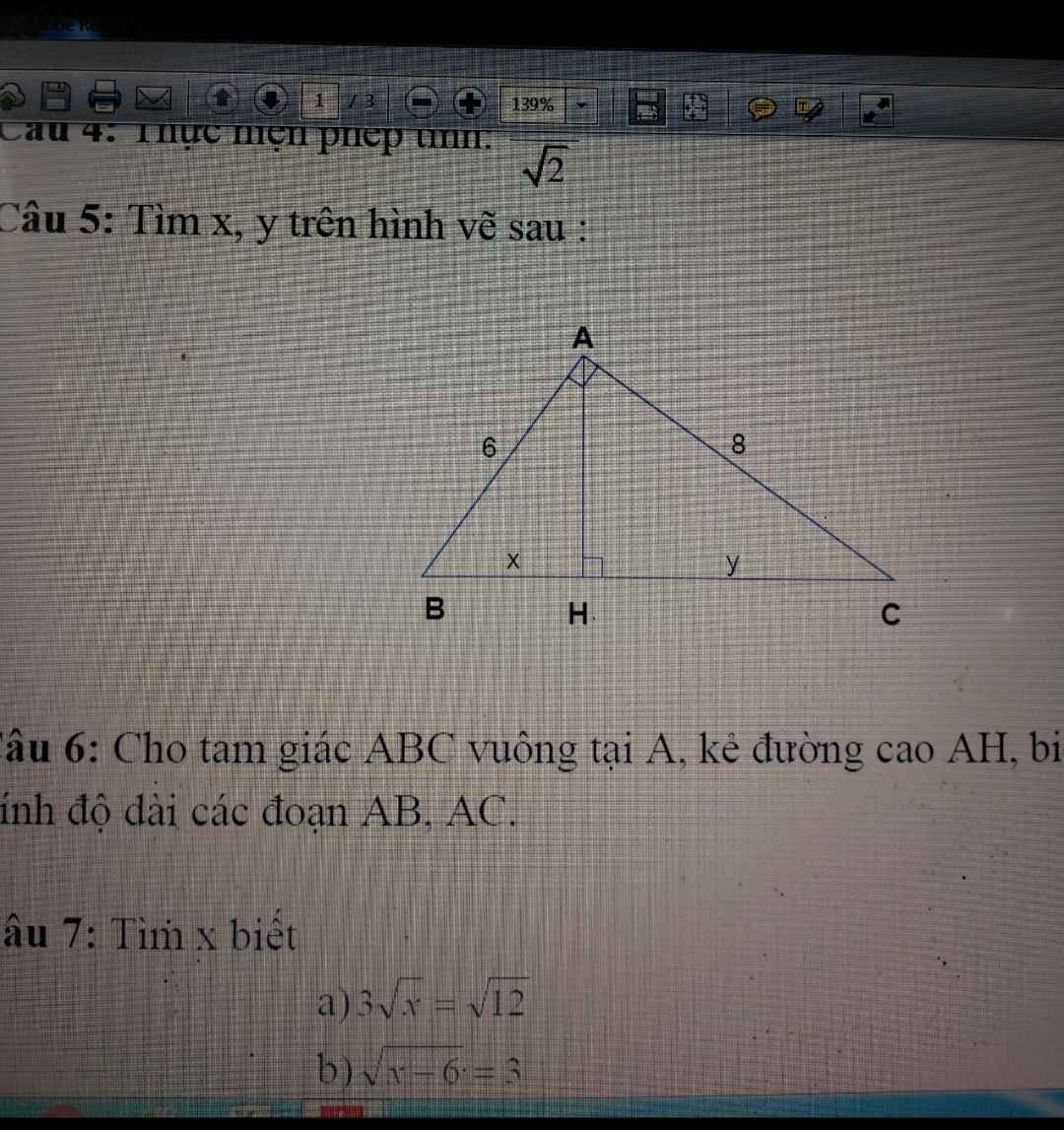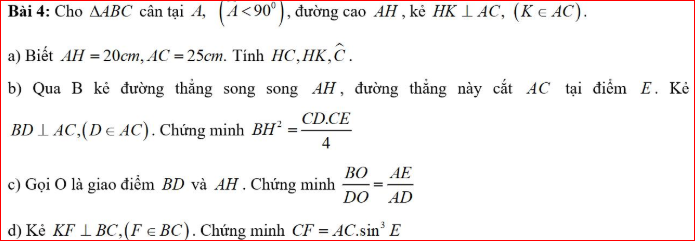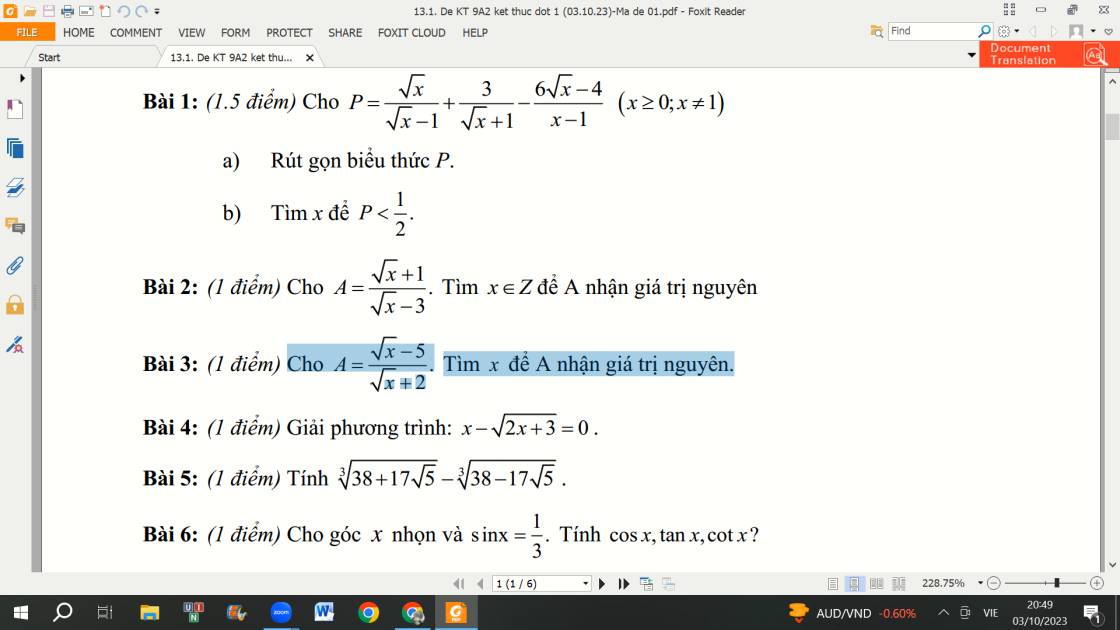
Hãy nhập câu hỏi của bạn vào đây, nếu là tài khoản VIP, bạn sẽ được ưu tiên trả lời.


câu 5:
x=3,6
y=6,4
câu 6: chụp lại đề
câu 7:
a)ĐKXĐ: \(x\ge0\)
\(3\sqrt{x}=\sqrt{12}\\ \Rightarrow9x=12\\ \Rightarrow x=\dfrac{4}{3}\)
b) ĐKXĐ: \(x\ge6\)
\(\sqrt{x-6}=3\\ \Rightarrow x-6=9\\ \Rightarrow x=15\)


c) A = x.M + (4x + 7)/(√x + 3)
= 3x/(√x + 3) + (4x + 7)/(√x + 3)
= (7x + 7)/(√x + 3)
Để A nhỏ nhất thì 7x + 7 nhỏ nhất
Mà x ≥ 0
⇒ 7x + 7 ≥ 7
⇒ GTNN của A là 7/3 khi x = 0

Bài 3.
a. Ta có: \(CK=BK\left(gt\right)\Rightarrow OK\perp BC\)
Ta có: \(\widehat{OIC}=90^o\)
\(\widehat{OKC}=90^o\)
\(\Rightarrow\widehat{OIC}+\widehat{OKC}=90^o+90^o=180^o\)
`=>` Tứ giác CIOK nội tiếp đường tròn
b. Xét \(\Delta AID\) và \(\Delta CIB\), có:
\(\widehat{AID}=\widehat{CIB}=90^o\left(gt\right)\)
\(\widehat{ADI}=\widehat{CBI}\) ( cùng chắn \(\stackrel\frown{AC}\) )
Vậy \(\Delta AID\sim\Delta CIB\) ( g.g)
\(\Rightarrow\dfrac{IA}{IC}=\dfrac{ID}{IB}\)
\(\Leftrightarrow IC.ID=IA.IB\)
c. Kẻ \(DM\perp AC\)
Ta có: \(\widehat{ACB}=90^o\) ( góc nt chắn nửa đtròn )
`->` Tứ giác DMCK là hình chữ nhật
\(\rightarrow DK\perp BC\)
Mà \(OK\perp BC\)
\(\Rightarrow\) 3 điểm D,O,K thẳng hàng

Bài 3:
Ta có: \(A=\dfrac{\sqrt{x}-5}{\sqrt{x}+2}=\dfrac{\sqrt{x}+2-7}{\sqrt{x}+2}=1-\dfrac{7}{\sqrt{x}+2}\)
A nguyên khi \(\dfrac{7}{\sqrt{x}+2}\) nguyên:
\(\Rightarrow7\) ⋮ \(\sqrt{x}+2\)
\(\Rightarrow\sqrt{x}+2\inƯ\left(7\right)=\left\{1;-1;7;-7\right\}\)
Mà: \(\sqrt{x}+2\ge2\)
\(\Rightarrow\sqrt{x}+2\in\left\{7\right\}\)
\(\Rightarrow x\in\left\{25\right\}\)

3) Ta có: \(\text{Δ}=\left[-2\left(m-1\right)\right]^2-4\cdot1\cdot\left(m^2-6\right)\)
\(=\left(2m-2\right)^2-4\left(m^2-6\right)\)
\(=4m^2-8m+4-4m^2+24\)
\(=-8m+28\)
Để phương trình có hai nghiệm phân biệt x1;x2 thì Δ>0
\(\Leftrightarrow-8m+28>0\)
\(\Leftrightarrow-8m>-28\)
hay \(m< \dfrac{7}{2}\)
Áp dụng hệ thức Vi-et, ta được:
\(\left\{{}\begin{matrix}x_1+x_2=\dfrac{2\left(m-1\right)}{1}=2m-2\\x_1x_2=m^2-6\end{matrix}\right.\)
Ta có: \(x_1^2+x_2^2=16\)
\(\Leftrightarrow\left(x_1+x_2\right)^2-2x_1x_2=16\)
\(\Leftrightarrow\left(2m-2\right)^2-2\left(m^2-6\right)-16=0\)
\(\Leftrightarrow4m^2-8m+4-2m^2+12-16=0\)
\(\Leftrightarrow2m^2-8m=0\)
\(\Leftrightarrow2m\left(m-4\right)=0\)
\(\Leftrightarrow\left[{}\begin{matrix}m=0\left(nhận\right)\\m=4\left(loại\right)\end{matrix}\right.\)

a: Xét (O) có
MA là tiếp tuyến
MB là tiếp tuyến
Do đó: MA=MB
hay M nằm trên đường trung trực của AB(1)
Ta có: OA=OB
nên O nằm trên đường trung trực của AB(2)
Từ (1) và (2) suy ra OM⊥AB

\(\left(\sqrt{7}-2\right)^2=11-4\sqrt{7}\)
\(\left(3-\sqrt{7}\right)^2=16-6\sqrt{7}=11-4\sqrt{7}+5-2\sqrt{7}\)
mà \(5-2\sqrt{7}< 0\)
nên \(\sqrt{7}-2< 3-\sqrt{7}\)

7. Ta có: \(\left(x+\sqrt{x^2+3}\right)\left(\sqrt{x^2+3}-x\right)=x^2+3-x=3\)
\(\Rightarrow\sqrt{x^2+3}-x=y+\sqrt{y^2+3}\Rightarrow x+y=\sqrt{x^2+3}-\sqrt{y^2+3}\left(1\right)\)
Lại có \(\left(y+\sqrt{y^2+3}\right)\left(\sqrt{y^2+3}-y\right)=y^2+3-y=3\)
\(\Rightarrow\sqrt{x^2+3}+x=\sqrt{y^2+3}-y\Rightarrow x+y=\sqrt{y^2+3}-\sqrt{x^2+3}\left(2\right)\)
Lấy \(\left(1\right)+\left(2\right)\Rightarrow2\left(x+y\right)=0\Rightarrow x+y=0\)
9. Ta có: \(\sqrt{55+\sqrt{109}}-\sqrt{55-\sqrt{109}}\)
\(=\sqrt{\dfrac{110+2\sqrt{109}}{2}}-\sqrt{\dfrac{110-2\sqrt{109}}{2}}\)
\(=\sqrt{\dfrac{\left(\sqrt{109}+1\right)^2}{2}}-\sqrt{\dfrac{\left(\sqrt{109}-1\right)^2}{2}}=\dfrac{\sqrt{109}+1}{\sqrt{2}}-\dfrac{\sqrt{109}-1}{\sqrt{2}}\)
\(=\dfrac{2}{\sqrt{2}}=\sqrt{2}\)
Lại có: \(\dfrac{\sqrt{2-\sqrt{4y-y^2}}}{y-2}.\sqrt{4+2\sqrt{4y-y^2}}\)
\(=\dfrac{\sqrt{4-2\sqrt{y\left(4-y\right)}}}{\sqrt{2}\left(y-2\right)}.\sqrt{\left(\sqrt{y}\right)^2+2\sqrt{y\left(4-y\right)}+\left(\sqrt{4-y}\right)^2}\)
\(\dfrac{\sqrt{\left(\sqrt{y}\right)^2-2\sqrt{y\left(4-y\right)}+\left(\sqrt{4-y}\right)^2}}{\sqrt{2}\left(y-2\right)}.\sqrt{\left(\sqrt{y}+\sqrt{4-y}\right)^2}\)
\(=\dfrac{\sqrt{\left(\sqrt{y}-\sqrt{4-y}\right)^2}}{\sqrt{2}\left(y-2\right)}.\left|\sqrt{y}+\sqrt{4-y}\right|=\dfrac{\left|\sqrt{y}-\sqrt{4-y}\right|}{\sqrt{2}\left(y-2\right)}.\left|\sqrt{y}+\sqrt{4-y}\right|\)
Vì \(y>2\Rightarrow\left\{{}\begin{matrix}\sqrt{y}>\sqrt{2}\\\sqrt{4-y}< \sqrt{2}\end{matrix}\right.\Rightarrow\sqrt{y}-\sqrt{4-y}>0\)
\(\Rightarrow\dfrac{\left|\sqrt{y}-\sqrt{4-y}\right|}{\sqrt{2}\left(y-2\right)}.\left|\sqrt{y}+\sqrt{4-y}\right|=\dfrac{\left(\sqrt{y}-\sqrt{4-y}\right)\left(\sqrt{y}+\sqrt{4+y}\right)}{\sqrt{2}\left(y-2\right)}\)
\(=\dfrac{y-\left(4-y\right)}{\sqrt{2}\left(y-2\right)}=\dfrac{2y-4}{\sqrt{2}\left(y-2\right)}=\dfrac{2\left(y-2\right)}{\sqrt{2}\left(y-2\right)}=\sqrt{2}\)
\(\Rightarrow\dfrac{\sqrt{2-\sqrt{4y-y^2}}}{y-2}.\sqrt{4+2\sqrt{4y-y^2}}=\sqrt{55+\sqrt{109}}-\sqrt{55-\sqrt{109}}\)










Vì \(y=\dfrac{1}{2}x^2\) có \(a=\dfrac{1}{2}>0\)
nên hàm số \(y=\dfrac{1}{2}x^2\) đồng biến khi x>0 và nghịch biến khi x<0